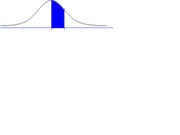User:Kevin Tan/Probability Distribution
From WikiEducator
Example : If N(42, 9) , evaluate
(i) P(X < 44)
(ii)P(40 < X < 45)
Solution: To use the standardised normal distribution table, you’ve to understand :
1. that 42 is the mean and 9 is the variance.
2. Then, need to convert P(X) to P(Z) by using the
formula P(Z < [math]\frac{x-\mu}{\sigma})[/math]
3.
4. The area below the curve is the probability, corresponding to the value of ‘z’ and the value from the table is just for the shaded region.
5. The graph is a symmetrical graph and we are reading the area of HALF the graph only.
6. The total area under the graph is 1 (ONE) and area of 0.5 on each side.
The worked example below will hopefully make it clear,…..
